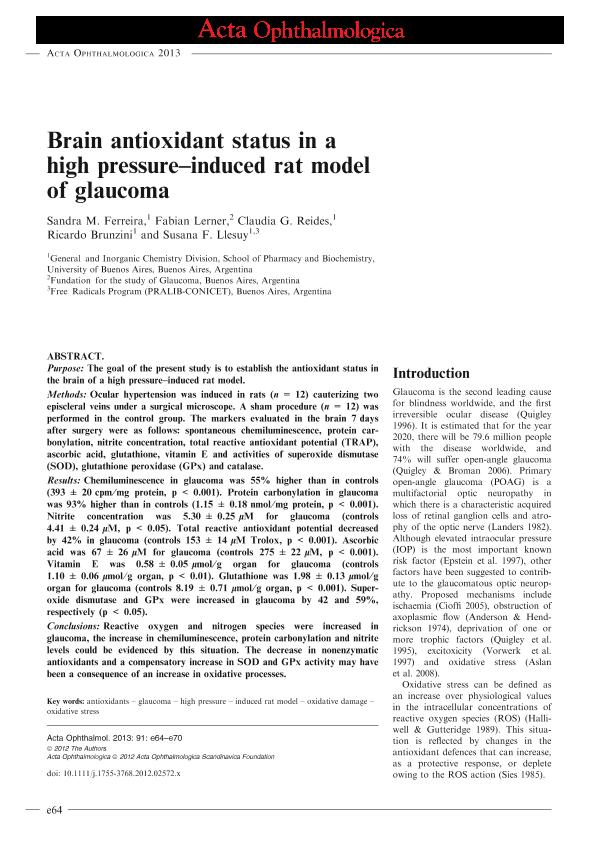Artículo
Brain antioxidant status in a high pressure–induced rat model of glaucoma
Ferreira, Sandra María; Lerner, Fabián; Reides, Claudia Gabriela; Brunzini, Ricardo; Llesuy, Susana Francisca

Fecha de publicación:
02/2013
Editorial:
Wiley
Revista:
Acta Ophthalmologica
ISSN:
1755-375X
e-ISSN:
1755-3768
Idioma:
Inglés
Tipo de recurso:
Artículo publicado
Clasificación temática:
Resumen
PURPOSE: The goal of the present study is to establish the antioxidant status in the brain of a high pressure-induced rat model. METHODS: Ocular hypertension was induced in rats (n = 12) cauterizing two episcleral veins under a surgical microscope. A sham procedure (n = 12) was performed in the control group. The markers evaluated in the brain 7 days after surgery were as follows: spontaneous chemiluminescence, protein carbonylation, nitrite concentration, total reactive antioxidant potential (TRAP), ascorbic acid, glutathione, vitamin E and activities of superoxide dismutase (SOD), glutathione peroxidase (GPx) and catalase. RESULTS: Chemiluminescence in glaucoma was 55% higher than in controls (393 ± 20 cpm/mg protein, p < 0.001). Protein carbonylation in glaucoma was 93% higher than in controls (1.15 ± 0.18 nmol/mg protein, p < 0.001). Nitrite concentration was 5.30 ± 0.25 μM for glaucoma (controls 4.41 ± 0.24 μM, p < 0.05). Total reactive antioxidant potential decreased by 42% in glaucoma (controls 153 ± 14 μM Trolox, p < 0.001). Ascorbic acid was 67 ± 26 μM for glaucoma (controls 275 ± 22 μM, p < 0.001). Vitamin E was 0.58 ± 0.05 μmol/g organ for glaucoma (controls 1.10 ± 0.06 μmol/g organ, p < 0.01). Glutathione was 1.98 ± 0.13 μmol/g organ for glaucoma (controls 8.19 ± 0.71 μmol/g organ, p < 0.001). Superoxide dismutase and GPx were increased in glaucoma by 42 and 59%, respectively (p < 0.05). CONCLUSIONS: Reactive oxygen and nitrogen species were increased in glaucoma, the increase in chemiluminescence, protein carbonylation and nitrite levels could be evidenced by this situation. The decrease in nonenzymatic antioxidants and a compensatory increase in SOD and GPx activity may have been a consequence of an increase in oxidative processes.
Palabras clave:
Glaucoma
,
Antioxidants
,
Brain
,
Oxidative Stress
Archivos asociados
Licencia
Identificadores
Colecciones
Articulos(IBIMOL)
Articulos de INSTITUTO DE BIOQUIMICA Y MEDICINA MOLECULAR
Articulos de INSTITUTO DE BIOQUIMICA Y MEDICINA MOLECULAR
Citación
Ferreira, Sandra María; Lerner, Fabián; Reides, Claudia Gabriela; Brunzini, Ricardo; Llesuy, Susana Francisca; Brain antioxidant status in a high pressure–induced rat model of glaucoma; Wiley; Acta Ophthalmologica; 91; 1; 2-2013; 64-70
Compartir
Altmétricas



